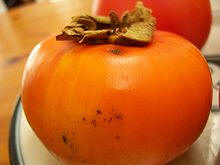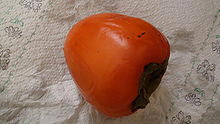
Persimmon U-Pick Orchards in Birmingham, Tuscaloosa and central Alabama in 2025, by county
Below are the U-Pick orchards and farms for persimmons that we know of in this area.
Not all areas of a state have persimmons orchards that are open to the public. If you know of any others, please tell us using the add a farm form!
Remember to always check with the farm's own website or Facebook page before you go - or call or email them if they don't have a website or Facebook page. Conditions at the farms and crops can change literally overnight, so if you want to avoid a wasted trip out there - check with the farm directly before you go! If I cannot reach them, I DON'T GO!
PLEASE report closed farms, broken links and incorrect info using the "Report Corrections" form below.
New! As inflation remains high, see this page for
reliable (tested) brands of generic canning lids at lower
costs, and cost-saving measures for
getting fruit and vegetables and home canning.
If you are having a hard time
finding canning lids, I've used these, and they're a great price & ship in 2 days.
New! Road tripping and camping is a great way to have a fun, safe and inexpensive family trip. The national and state parks and monuments are open, and campgrounds usually cost between $10 and $40 per night. September to November is the best camping weather. See our new website Road Tripping and Camping.com for tips, tricks, guides, checklists and info about parks, monuments and other places to visit.
New! We just went live with our latest website, FunFactoryTours.com - As they name implies, you can find a fun factory tour, including chocolate, automobiles, historical forts and sites, famous buildings, Active Federal facilities even fun geology: like fossils and volcanic areas
Cullman County
- Sloshie Mae's Farm - No pesticides are used, blackberries, figs, muscadine grapes, pears, persimmons,
255 County Road 1823, Arab, AL 35016. Phone: . Email: Sloshiemae@gmail.com. Open: Hours and availability of crops to pick varies considerably; please email for current availability and hours. Directions: From Arab go South on Highway 231, turn right onto county road 1763 then go 1.7 miles, turn left onto County Road 1823. Our farm is at the top of the first hill on left. Click here for a map and directions. Payment: Cash, only. 7 miles, turn left onto County Road 1823. Our farm is at the top of the first hill on left. . W. We do not use pesticides on the crops. Apple varieties (in years when we have a good crop - call first): Fuji, Gala, McIntosh and Granny Smith. Pear varieties: Hosui, Bartlett, Chojuro, Shinko, Orient, Pineapple and Kieffer. Fig varieties: Brown Turkey and Texas Everbearing. Persimmon Varieties: American, Giant Fuyu, Fuyu, Tanenashi and Hachiya. Plum varieties: Methley and Santa Rosa. Pear varieties: Hosui are ready August(This is our top seller and very sweet), Bartlett are ready August to September, Chojuro/Shinko/Orient/Pineapple are ready September, Kieffer-October to November. (UPDATED: April 22, 2025, JBS) (UPDATED: July 06, 2018)
[ Click here to update the listing ]
Talladega County
- Holmestead Farm - Strawberries, Blackberries, Blueberries, Raspberries, Peaches, Nectarines, Plums, Plumcots, Grapes (red, white, black), Saturn (Do-Nut) peaches, Asian Pear, Regular Pears, Apples, Japanese Persimmons, Figs, Muscadines, grapes, Scuppernongs, Satsumas, Meyer Lemons, Chestnuts, Pomegranates
6582 County Road 7, Talladega, AL 35160. Phone: 256-404-4316. Email: holmesteadfarm@yahoo.com. Open: see their website. Directions: From TalladegaOn Hwy 77 South, turn right at the 52 mile marker onto Hwy 77. In 11.2 miles, turn right onto County Road 7. In 6.5 miles, turn right onto Clay County 7. Our driveway will be on the right in 3.5 miles. U-PICK WE-PICK FARM COUNTRY STORE & MARKET. Typical harvest seasons are: Strawberries - Late March thru June - 40,000 plants:Blackberries - Late May thru early June - 1400 plants:Blueberries - May thru July - 800 bushes: Raspberries - Late May thru early June - 600 plants:Peach - truncated. Click here for a map and directions. In 11.2 miles, turn right onto County Road 7. In 6.5 miles, turn right onto Clay County 7. Our driveway will be on the right in 3.5 miles. U-PICK / WE-PICK FARM COUNTRY STORE & MARKET. Typical harvest seasons are: Strawberries - Late March thru June - 40,000 plants:Blackberries - Late May thru early June - 1400 plants:Blueberries - May thru July - 800 bushes: Raspberries - Late May thru early June - 600 plants:Peaches - April thru Sep - 400 trees:Nectarines - May thru August - 30 trees:Plums - April thru August - 250 trees:Plumcots - June - 20 trees:Grapes (red, white, black) - Late June thru early July - 30 plants:Saturn (Do-Nut) peaches - June - 35 trees:Asian Pear - August thru November - 75 trees:Regular Pears - July thru November - 25 trees:Apples - July thru November - 150 trees:Japanese Persimmons - Late Sep thru Nov - 75 trees:Figs - August thru October - 75 trees:Muscadines & Scuppernongs - August thru October - 150 plants:Satsumas - Late September thru November - 25 trees:Me..
[ Click here to update the listing ]
Persimmons

Persimmon Picking Tips, Recipes and Information
Persimmons, are a VERY tart and rare fruit. More popular in Asia, the Asian varieties have been introduced to North America and become popular. Native North American Fuyu persimmons (shown at top right) are flattened in shape.
The Asia hachiya persimmons are more elongated and a bit sweeter. All persimmons are exceedingly tart until the are dead-ripe and slight mushy in texture.
Uses:
Persimmons are typically made into jelly, but also used for their flavor in baked goods such as muffins, tarts and sauces. Persimmon berries also freeze well.

If you're looking for great, easy to follow recipes to make jelly, see these pages:
Harvesting Season:
The exact timing of Persimmon harvest can vary depending on your location and climate, but it generally occurs in the summer months. In most regions, you can expect to start harvesting Persimmons from late July to early August.
Persimmons are an unusual fruit because they actually DO ripen after being harvested. In fact, it is BEST to pick the persimmons while they are hard, and allow them to ripen and soften in a cool basement. This avoid bug and bird danage.
Determining Ripeness:
Ripe Persimmons are soft, almost mushy, and have a bright orange color.
How to pick or harvest:
To harvest Persimmons, simply hold the branch beneath and gently pluck them off with your fingers. It's best to place a container or basket beneath the branch to catch them if they fall.
Handling and Storage:
After harvesting, sort through the fruit and remove any damaged or overripe ones. Store them in a shallow container, preferably in a single layer, to prevent crushing and allow for proper airflow. Refrigerate them when they become ripe and soft; consume them within a few days for optimal freshness. If you have an abundant harvest, consider freezing them for longer-term storage.
Other Local Farm Products (Honey, Horses, Milk, Meat, Eggs, Etc.)
(NOT pick-your-own, unless they are also listed above)
- Farm markets and roadside stands
- Local Honey Finder
- Local Meat, Milk and Eggs
- Venues: Farms, Wineries, Orchards for your event, wedding or party
- Easter egg hunts
- Children"s consignment sales
- Fruit and vegetable festivals
- Winery tours and wine tastings
- Horse rides, stables, lessons, trails
- Maple Syrup farms and sugarworks
- Bed & Breakfasts on Farms, Wineries, Ranches and Orchards
- Pumpkin patches
- Corn mazes
- Zombie Paintball venues
- Christmas Tree Farms & lots
- Environmental resources
- Consumer fraud information
- Wholesale food sources
- Resources for Farmers
Looking for canning equipment and supplies?
Water bath canner with a jar rack
Pressure canners for gas, electric and induction stoves: Presto 23Qt or T-fal 22Qt
Canning scoop (this one is PERFECT)
Ball Blue book (most recent version)
Jars: 8oz canning jars for jams
Find Other types of farms:
Farm markets and roadside stands
Road trips and camping resources
Local Honey, apiaries, beekeepers
Consumer fraud and scams information
Home canning supplies at the best prices on the internet!
Maple Syrup Farms, sugarworks, maple syrup festivals
Environmental information and resources
Farms For Your Event for birthday parties, weddings, receptions, business meetings, retreats, etc.
Festivals - local fruit and vegetable festivals
Get the
most recent version of
the Ball Blue Book
With this Presto 23 quart pressure canner and pressure cooker, you can "can" everything, fruits, vegetables, jams, jellies, salsa, applesauce, pickles, even meats, soups, stews. Model 01781

You can make jams, jellies, can fruit, applesauce, salsa and pickles with water bath canners, like this Granite Ware 12-Piece Canner Kit, Jar Rack, Blancher, Colander and 5 piece Canning Tool Set

